Samaritans hunts for digital expertise after admitting it hasn’t been ‘at the forefront’
Samaritans has admitted that it hasn’t been “quick on the uptake” with digital and needs to find better ways of interacting with supporters online as it looks to hire its first digital communications head.
https://www.youtube.com/watch?v=NdKa2FRMJSE
The charity has today (29 October) launched its first social media app as it looks to improve on its digital communications and make the online environment safer. The Radar app (see above) aims to inform consumers if one of the people they follow on Twitter sends out messages that cause the charity concern.
Speaking to Marketing Week, Samaritans’ executive director of policy research and development Joe Ferns, says the charity has previously done “bits and pieces” to help people that might be vulnerable online.
This includes partnerships with Google and Apple’s Siri that means if someone is searching for topics that cause the Samaritans concerns it pops up in the search results or Siri offers to ring. However, Ferns admits those are “fairly blunt” solutions and that it needs to look at more ways it can provide its service on social media and through digital channels.
“We are increasingly worried about the experience of people who talk to each other, try to seek help, go online and don’t find the help they need. What we’ve got to do is find ways of creating solutions that make the online environment safer but without being intrusive or taking away from what the online environment is about, which is user owner, user generated and the fact you have to respect the sub cultures,” he adds.
The Samaritans is set to move into new strategy period, which sets its direction through to 2021, next year, with the focus on finding ways to catch up in digital, where Ferns admits the charity “hasn’t been at the forefront”.
It is currently looking to hire its first head of digital communications amid a wider structure of its communications department. This will see the creation of three new roles – head of digital, head of marketing and head of press and PR – that will report in the communications director and have direct leadership for their specific functional areas.
“We want to ensure these functions are represented at a higher level and increase the number of people who work in digital communications and their seniority. This is a symptom of a charity growing its capability to ensure we punch above our weight in communication.
“The instinct has been to put our resources into service with the temptation to see [communications] as not being part of the service. Of course actually it is important that people who might potentially need our support understand who we are and how they can contact us,” says Ferns.
Ferns hopes that the Radar app, which was created by digital agency Jam in partnership with Twitter, will help people realise that small gestures, such as asking someone if they are OK, can make a big difference to vulnerable people. The aim, he says, is not to raise the brand’s profile but to encourage people and give them the confidence and skills to talk to each.
He says that concerns over privacy, which have been raised since the app launched, are ill-founded, highlighting that the information on at-risk people is only provided if people sign up to use the app and the Samaritans will not be “popping up cold” in people’s social media feeds. It also only makes use of public updates.
While the alert people receive is “fairly generic” at the moment, the Samaritans hopes to make it “more sensitive” to different issues such as eating disorders or drug problems. The charity is also looking at how it could expand it beyond Twitter, as well as how it could better communicate with people across other digital platforms such as instant messaging or by creating moderated communities.







